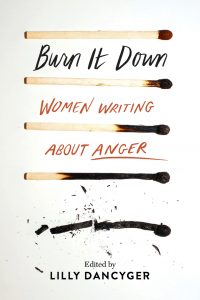Burn It Down
 When an editor at Seal Press approached me in March, 2018 and asked if I might be interested in editing an anthology of essays on women’s anger, I waited to hear what the catch was going to be. There was no way such a perfect project could just fall into my lap! It felt like they’d read my mind (I suspect they read my Twitter…) But there was no catch—they’d developed the idea for this project in-house, and were in need of an editor to take the helm.
When an editor at Seal Press approached me in March, 2018 and asked if I might be interested in editing an anthology of essays on women’s anger, I waited to hear what the catch was going to be. There was no way such a perfect project could just fall into my lap! It felt like they’d read my mind (I suspect they read my Twitter…) But there was no catch—they’d developed the idea for this project in-house, and were in need of an editor to take the helm.
I’d recently worked with them to contribute an essay to the rerelease of another great anthology of theirs, Michelle Tea’s Without a Net, so the timing was right. (This was also a great reminder for me that you never know what doors any small project might open. I was thrilled to write a piece for Without a Net—I wrote about “passing as privileged” as a poor kid who ended up in an industry mostly made up of… not poor people—but I had no idea that essay would lead to a book deal when I wrote it.)
Like many women, I’d been holding in a vast anger for most of my life, and it had started spilling over in the last few years. The 2016 election changed everything. It did away with any illusion that we were slowly but surely marching toward a better world, with equality and justice for all. It was a harsh awakening for many of us, and when Seal approached me about this project, just over a year after Donald Trump took office and six months after the #MeToo movement took off, I was positively seething.
I was grateful for a productive, creative way to channel that anger, to connect with other women who were just as furious as I was, and maybe even to break open a necessary part of the conversation about what to do next.
At the forefront of my mind from the very beginning as I started to solicit contributors was the importance of making this anthology diverse and inclusive—there are so many ways that the topic of women’s anger intersects with racial, cultural, and religious identities, and I wanted to cover as wide a range as possible. I ended up with 22 essays total, but the truth is that even if I’d included 200, there was no way to ever cover the entirety of women’s anger in one book. Still, I tried.
It was particularly important to me to include essays from women whose anger is especially policed—even as we make strides toward more space for certain women (read: white, cis, straight, thin, conventionally attractive women) to express themselves, the “angry Black woman” stereotype persists, as does the “fiery Latina”—both rooted in racism and used to dismiss women of color when they speak up for themselves, whether they’re actually angry or not.
And because people who argue that trans women aren’t “really” women are repugnant trolls, I wanted to make sure that trans women were strongly represented in the anthology. I also knew that a few great trans women writers I knew would have a really interesting perspective on the topic of anger as it relates to gendered socialization.
Originally when Seal pitched the idea to me, they framed it as being by and for “women and nonbinary people.” I went forward with that framing at first, but I learned along the way, from following nonbinary people on twitter and reading what they had to say on the matter, that lumping them in with women is actually more tokenizing than inclusive.
Generally, when people say “women and nonbinary people,” they really mean women and nonbinary people who were assigned female at birth—which, even when well-intentioned, erases AFAB nonbinary people’s identity by lumping them in with the binary gender they’ve rejected. It also excludes AMAB nonbinary people, and is overall just not the right approach. This really crystalized for me when I started to write the introduction for the book and realized that everything I had to say, the larger message I was trying to get across, really was about women’s anger, specifically, and that throwing nonbinary people in like an afterthought would do everyone a disservice.
In addition to diversity in the identities and backgrounds of the writers, I thought about specific topics I wanted to make sure to touch on—motherhood, aging, sexual assault, disability, body image, and religion were a few. I didn’t want to pigeonhole writers by limiting them to writing about their specific identities—like approaching a Black writer specifically to write about Black women’s anger, or approaching a disabled writer specifically to write about disability—so I thought of the identities of the contributors and the topics of the essays as two different things to keep track of.
I approached writers by telling them about the project and asking if there was anything they might want to write about—leaving it open to them to focus on identity or to take it somewhere totally different. I tried to follow the writers where they led me, more than starting with a specific idea of what the book would look like and then pushing writers to conform to that.
Once I had all the writers and topics lined up, it was just a matter of herding cats! The editing process was several months long, going back and forth with writers to get their essays perfect, then sending them to the press to be edited again… a few pieces ended up getting killed or withdrawn during that process because they either weren’t quite coming together, or they didn’t seem to fit with the rest of the essays. There’s a wide variety of styles, topics, and approaches, but there’s a certain fire that holds them all together.
Then putting them all in order to tell a larger story was fun and challenging! I started with Leslie Jamison’s piece because it felt like an overture, a really broad cultural look at women’s anger to set the tone for the book; and I ended with Anna Fitzpatrick’s because her piece focuses as much on forgiveness and moving on as it does on anger.
—
Lilly Dancyger is a contributing editor and columnist at Catapult, and assistant editor at Barrelhouse Books. She’s the editor of Burn it Down, an anthology of essays on women’s anger from Seal Press, and her writing has been published by Longreads, The Washington Post, Glamour, Playboy, Rolling Stone, and more. Lilly lives in New York City, and she spends way too much time on twitter (where you can find her at @lillydancyger).
BURN IT DOWN
 A rich, nuanced exploration of women’s anger from a diverse group of writers
A rich, nuanced exploration of women’s anger from a diverse group of writers
Women are furious, and we’re not keeping it to ourselves any longer. We’re expected to be composed and compliant, but in a world that would strip us of our rights, disparage our contributions, and deny us a seat at the table of authority, we’re no longer willing to quietly seethe behind tight smiles.
We’re ready to burn it all down.
In this ferocious collection of essays, twenty-two writers explore how anger has shaped their lives: author of the New York Times bestseller The Empathy Exams Leslie Jamison confesses that she used to insist she wasn’t angry-until she learned that she was; Melissa Febos, author of the Lambda Literary Award-winning memoir Abandon Me, writes about how she discovered that anger can be an instrument of power; editor-in-chief of Bitch Media Evette Dionne dismantles the “angry Black woman” stereotype; and more.
Broad-ranging and cathartic, Burn It Down is essential reading for any woman who has scorched with rage-and is ready to claim her right to express it.
Category: How To and Tips
























